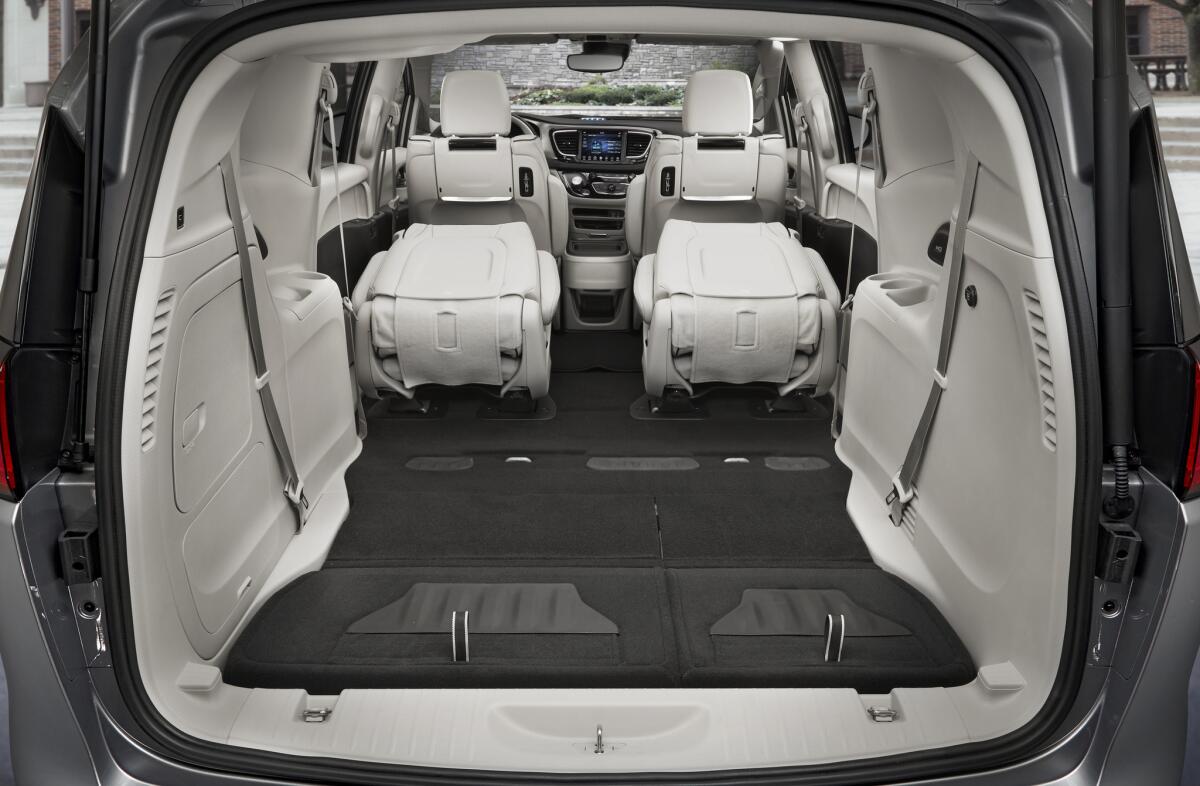Review: 2017 Chrysler Pacifica: Americaâs first plug-in hybrid minivan
FCAâs Chrysler division has beaten its competitors to market with the countryâs first plug-in hybrid minivan.
But is this the answer to the question no one has been asking? Does anybody want one?
Chryslerâs gasoline-powered Pacifica fights for market share with Hondaâs Odyssey,
The company has done well with this van. Chrysler sold 62,336 Pacificas last year, and is on pace to beat that for 2017, with 35,479 units sold through April.
The bump in sales may be coming from the new hybrid version, though
That could mean there are some happy new minivan owners out there, because the hybrid Pacifica is a very appealing people mover.
Smooth operator
The Pacifica Hybrid combines FCA's 3.6-liter V-6 gasoline engine with an electric motor, together driven through a nine-speed transmission.
With an estimated 33 miles of battery-powered electric range, as rated by the
Chrysler says it goes from zero to 60 miles per hour in 7.3 seconds -- not neck-slappingly fast, but pretty good for a minivan.
Itâs so smooth and quiet in all-electric mode that the gentle arrival of the gasoline motor, chugging up a steep hill, is a little disappointing.
But thatâs the only disappointment. In electric, gas or mixed driving mode, the Pacifica is easy to operate and fun to drive. It accelerates to freeway speed with confidence, passes with authority and around town is zippy and quick off the mark.
Visibility is good, all the way around â which makes up for the not very good backup camera images on the information screen.
The Platinum version I drove was loaded with appealing attributes. The sliding doors open and close at the push of a button, as does the power liftgate. The remote start system enables the driver to turn the car on and set the climate control via a cellphone app in preparation for a drive. (It turns off automatically if the car isnât occupied within 15 minutes.)
The UConnect phone pairing system booted up on the first try â which shouldnât be surprising, except that so many vehicles still have difficulty in this area â and delivered acceptable audio quality.
Available as options are lane departure warning systems, forward collision prevention systems, a 360-degree surround camera, parallel and perpendicular park assist, and more.
Active noise cancellation keeps the cabin very quiet. A good Alpine speaker system fills it with music. A 7-inch information screen keeps the driver in touch with the drive and the vehicle.
Thereâs even a CD/DVD player.
Cabin comfort extends to the passengers.
The second-row seats have their own climate control station, individual seat-back entertainment screens and multiple device plug-ins.
The third-row seats have their own HVAC vents, plus cupholders, sunshades and sunroof.
That's a long way from riding in the back seats, in the old family station wagon, with the rear window down, getting sleepy on carbon monoxide fumes, the way I did as a kid.
Boasting a best-in-class storage capacity, the Pacifica features FCAâs Stow N Go system, which enables the third-row seats to be folded and tucked away, out of sight, into the floor.

The hybrid system produces great fuel economy, getting an EPA estimated 84 miles per gallon equivalent in hybrid mode. But it also gets a 32 mpg in gasoline-motor mode, the EPA said, which is good for a vehicle this size. Total range is said to be 566 miles.
The EPA estimates that Pacifica Hybrid owners will save $2,500 in fuel costs over five years, compared with the average new vehicle of all types.
That, and possible state and federal incentives, may help offset the suggested retail price, which isnât cheap. While the entry-level nonhybrid Pacifica starts at only $30,090, the hybrid versions begin at $13,000 more than that -- and then goes up.
But the company isn't pushing the hybrid technology, especially the "plug-inâ part.
Chrysler isn't promoting that because, as one executive explained, talking to people about battery power creates ârange anxiety.â For some car shoppers, concern about being stranded with a dead battery may actually prevent them from understanding that they can never run out of electric driving range, because the gasoline engine always takes over when the battery power runs low.
For now, Chrysler has the hybrid minivan field to itself. That may not last.
Honda has said it will be putting its current hybrid technology into a broader range of vehicles, which could mean a minivan.
Toyota already sells the Estima hybrid minivan in Japan, and could bring a hybrid Sienna to market here, though the company has said it will not do so for the 2018 model year.
For now, stable gasoline prices and continued unfamiliarity with hybrid technology have kept sales of plug-ins relatively low. More quality plug-in vehicles in the market, such as the Chevy Volt, Chevy Bolt EV and this minivan, could change that.
2017 Chrysler Pacifica Hybrid
Timesâ take: First U.S. plug-in hybrid minivan
Highs: Silent power, frugal on fuel
Lows: Could be plagued with first-year bugs
Vehicle type: Five-door, seven-passenger minivan
Base price: $43,090
Price as tested: $47,885
Powertrain: Hybrid system with 3.6-liter gas engine
Transmission: EFlite electrically variable
Horsepower: 220 (gas motor only); 260 (combined)
Torque: 235 pound-feet (gas motor only)
EPA fuel economy rating: hybrid: 84 miles per gallon equivalent, combined city / highway; gasoline engine only: 32 miles per gallon combined city / highway




